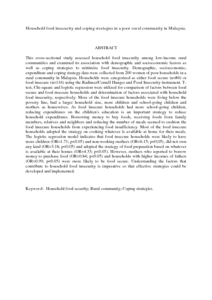Citation
Mohd Shariff, Zalilah and Khor, Geok Lin
(2008)
Household food insecurity and coping strategies in a poor rural community in Malaysia.
Nutrition Research and Practice, 2 (1).
pp. 26-34.
ISSN 1976-1457; ESSN: 2005-6168
Abstract
This cross-sectional study assessed household food insecurity among low-income rural communities and examined its association with demographic and socioeconomic factors as well as coping strategies to minimize food insecurity. Demographic, socioeconomic, expenditure and coping strategy data were collected from 200 women of poor households in a rural community in Malaysia. Households were categorized as either food secure (n=84) or food insecure (n=116) using the Radimer/Cornell Hunger and Food Insecurity instrument. T-test, Chi-square and logistic regression were utilized for comparison of factors between food secure and food insecure households and determination of factors associated with household food insecurity, respectively. More of the food insecure households were living below the poverty line, had a larger household size, more children and school-going children and mothers as housewives. As food insecure households had more school-going children, reducing expenditures on the children's education is an important strategy to reduce household expenditures. Borrowing money to buy foods, receiving foods from family members, relatives and neighbors and reducing the number of meals seemed to cushion the food insecure households from experiencing food insufficiency. Most of the food insecure households adopted the strategy on cooking whatever is available at home for their meals. The logistic regression model indicates that food insecure households were likely to have more children (OR=1.71; p<0.05) and non-working mothers (OR=6.15; p<0.05), did not own any land (OR=3.18; p<0.05) and adopted the strategy of food preparation based on whatever is available at their homes (OR=4.33; p<0.05). However, mothers who reported to borrow money to purchase food (OR=0.84; p<0.05) and households with higher incomes of fathers (OR=0.99; p<0.05) were more likely to be food secure. Understanding the factors that contribute to household food insecurity is imperative so that effective strategies could be developed and implemented.
Download File
![[img]](http://psasir.upm.edu.my/15029/1.hassmallThumbnailVersion/Household%20food%20insecurity%20and%20coping%20strategies%20in%20a%20poor%20rural%20community%20in%20Malaysia.pdf)  Preview |
|
PDF (Abstract)
Household food insecurity and coping strategies in a poor rural community in Malaysia.pdf
Download (84kB)
| Preview
|
|
Additional Metadata
Actions (login required)
 |
View Item |

